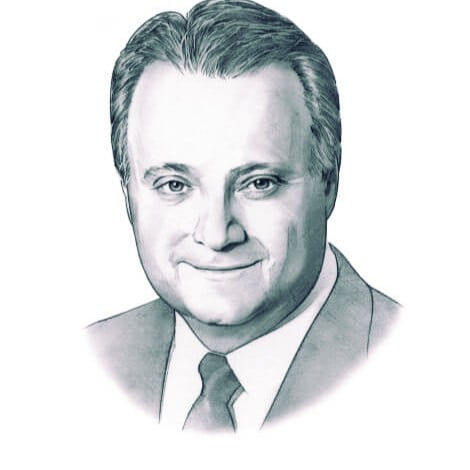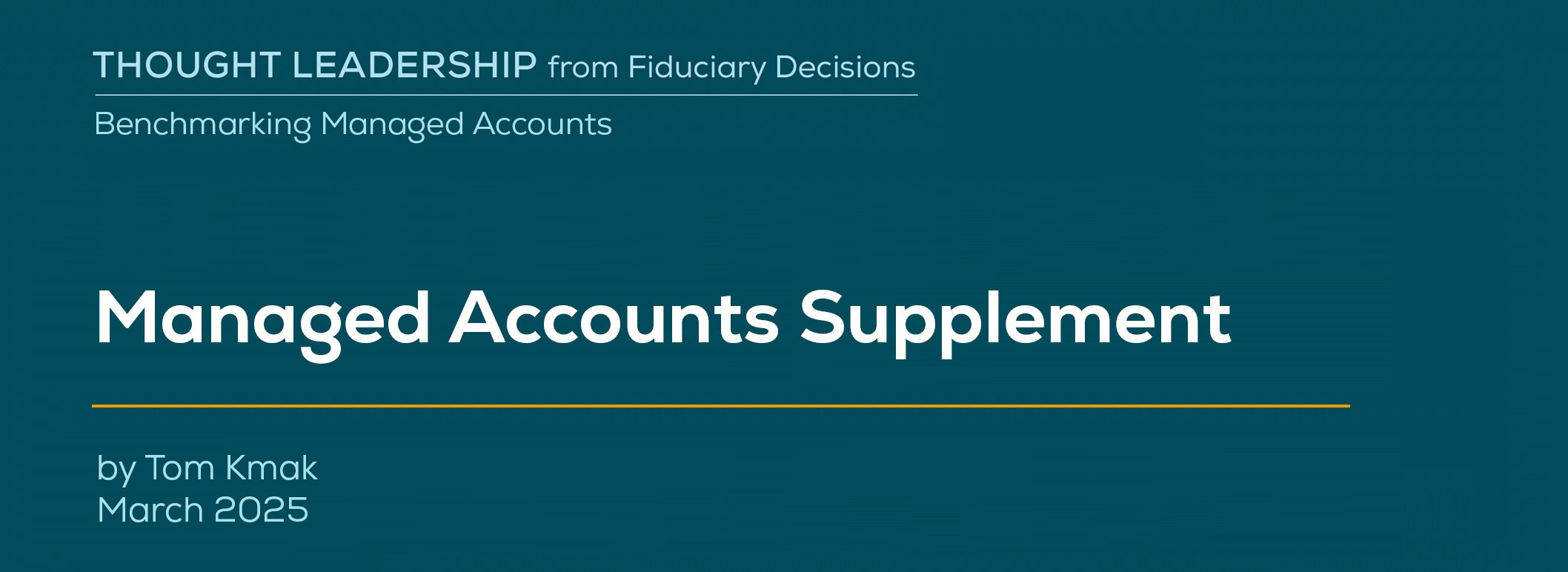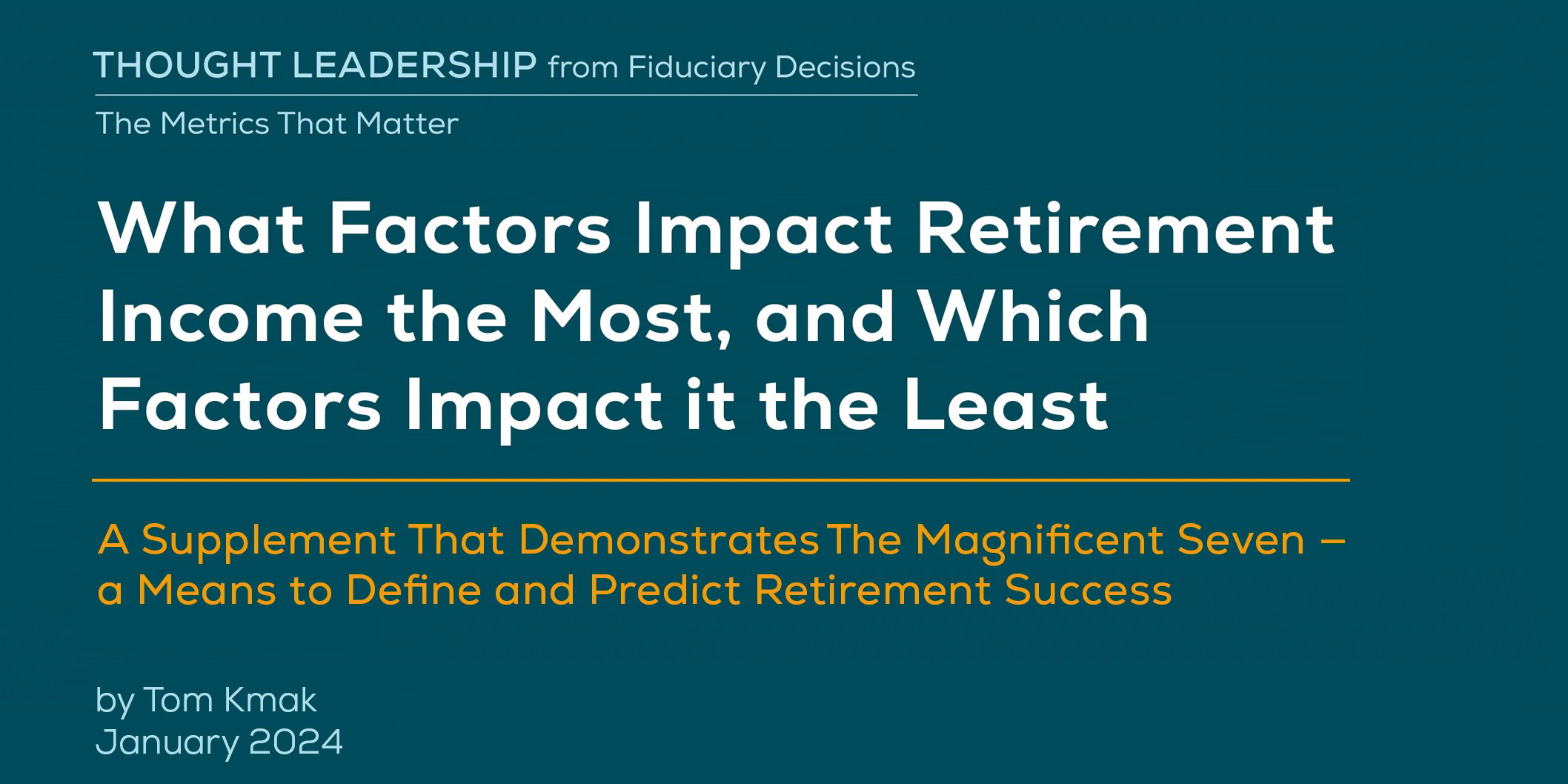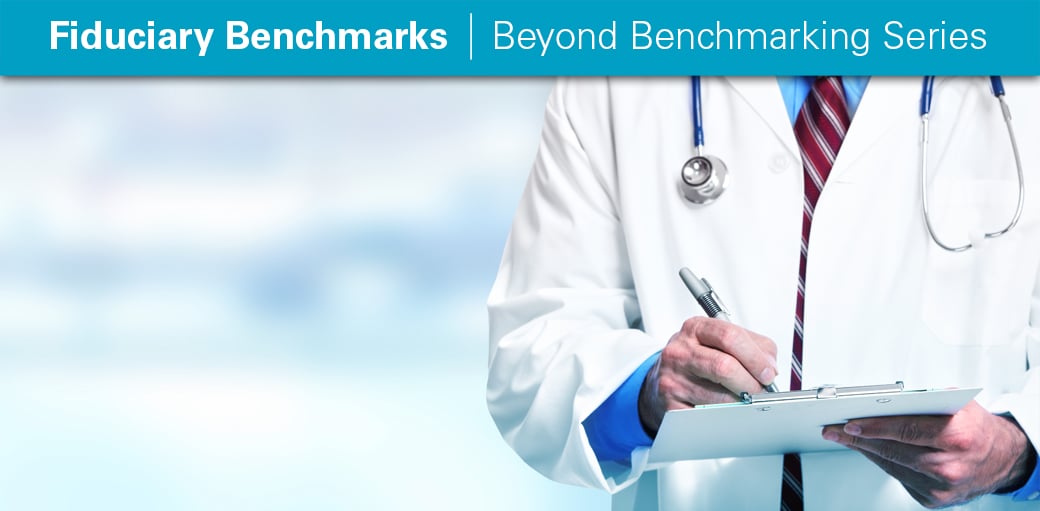Five Steps to Benchmark Managed Accounts
by Tom Kmak, Chief Executive Officer
Mar 26, 2025

If you have been watching the ERISA litigation front lately, you will have seen quite a few suits regarding Managed Accounts.
According to the FDI ERISA Litigation Database, 17 Plan Committees have been sued regarding the Managed Account option in their plan. Of those 17, some have settled with no admission of guilt (for example, the R.R. Donnelley settlement for $1.2 million in January 2024), and others have had their cases dismissed at the pleading stage (the example here being the Bechtel case in January 2025).
Regardless of the ERISA litigation front, however, Fiduciary Decisions (FDI) has seen increasing demand for an answer to the question: “How should I be benchmarking my Managed Account provider?” In response, we recommend the same tried and true (and patented) 5-step methodology FDI uses for Benchmarking 401(k) plans.

 Build a Benchmark Group
Build a Benchmark Group
The first step is to answer this question: What is the Benchmark Group for a Managed Account Provider? Well, if you examine the lawsuits, they contend you should look INSIDE the plan to see if Participants paying MORE for Managed Accounts are receiving MORE than participants NOT in Managed Accounts. And by more, we mean better Retirement Outcomes. Thus, FDI looks at the participants in the plan and sorts them into 3 Benchmark Groups:
1. Those in Managed Accounts
2. Those with 90% or more of their assets in Target Date Funds
3. Do-It-Yourself (DIY) participants (these are all other participants not in the first 2 categories)
 Consider the Quality of the Managed Account Provider
Consider the Quality of the Managed Account Provider
The DOL information letter to Theodore Konshak, issued on December 1, 1977 (known as the Konshak letter) informs fiduciaries that they CAN consider the Quality of any Service Provider when assessing the reasonableness of fees being paid to that provider. In this regard, FDI knows Managed Account providers with a rich history and deep staff to successfully build the algorithm that drives the Managed Account program. On the other hand, FDI is familiar with an Advisor of smaller retirement plans in the Southeast that has a proprietary algorithm that has produced impressive rates of return. Either way, it is important for Fiduciaries to consider the People, Processes and Technology of their Managed Account providers.
 Consider the Services of the Managed Account Provider
Consider the Services of the Managed Account Provider
The next step is to consider the Service of your Managed Account Provider. Shown below are just a few of the services that may differ from one Managed Account Provider to the next:
- Personalized proactive email campaigns encouraging the right “next step” for the participant
- An 800-number to help participants answer questions
- An algorithm that helps the participant optimize Social Security
- An algorithm that advises and helps participants purchase an annuity (if so desired)
- The number of days it takes to remove or add a new investment option to the plan
- The ability to track call activity during “extreme” events
Quite simply, there are differences between Managed Account Providers and the services they provide and according to case law, these differences should be considered when assessing the reasonableness of their fees.
 Consider the Value Delivered by the Managed Account Provider
Consider the Value Delivered by the Managed Account Provider
The Value Delivered is quite simply the most important part of benchmarking a Managed Account provider. It can be dissected into the sample table shown below:

To put it simply, if a participant is paying a Managed Account provider a fee to improve retirement outcomes, that Managed Account provider should help participants improve their Saving, Investing and Spending behavior. Plus, and this is a new thought from FDI encapsulated in the red box, we believe the Managed Account Provider should help the participant establish a personal retirement goal as research shows about 75% of participants retire before age 65. And of course, they should then inform the participants how well they are doing against this custom goal. This is a significant component of the Managed Account service as our experience shows it is not being done without a Managed Account.
 Consider the Fees Charged by the Managed Account Provider
Consider the Fees Charged by the Managed Account Provider
Finally, you should examine the Fees charged by the Managed Account provider, which historically decreases as the account balance increases, as shown in the table below:

You will note that by considering the percentage of assets in each category (in red), you can see a single weighted average fee for the plan versus all the other plans in the Benchmark Group (the last two boxes at the bottom). This allows the Plan Fiduciary to see if the Fees they are paying are reasonable in light of the Quality, Services and Value delivered by the Managed Account provider.
In closing, a lot of critics of Managed Accounts argue they are nothing more than expensive Target Date Funds. In some cases, that may be true, but as you can see from the data above, a Managed Account with better Saving, Investing, and Spending behavior can be worth much more than the annual basis point fee.
WE CAN HELP
Please share this Five Steps to Benchmark Managed Accounts with Plan Sponsors, Advisors and other service providers to encourage them to consider the impact that participant behavior and Managed Accounts can have on retirement outcomes.
Click here for the supplement: “Manage Accounts Supplement.”
About Author:

Tom Kmak, Chief Executive Officer
Tom Kmak is the co-founder and Chief Executive Officer of Fiduciary Decisions (FDI, formerly Fiduciary Benchmarks). During his 16 years with the firm, FDI has become the industry’s leading firm for benchmarking retirement plans using a patented approach that recognizes the mathematical truth that “Fees Without Value is a Meaningless Comparison.” Tom is pleased to say that FDI’s benchmarking service is used by 70% of the largest and most prestigious Recordkeepers as well as over 60% of the best Retirement Plan Advisors as recognized by various industry publications. Tom has also been involved in the development of other services at Fiduciary Decisions, such as the Rollover Decision Support System supporting DOL PTE 2020-02, as well as the interactive plan design tool called the Retirement Outcomes Evaluator.
Prior to founding FDI, in 1990 Tom started the JPMorgan Retirement Plan Services business with American Century. Upon leaving in October 2007, that business employed 1,100 people serving two hundred large plan sponsors with over 1.5 million participants and more than $115 billion in assets. During his career with Retirement Plan Services, the company initiated numerous industry firsts including no blackout conversions and the innovative employee education program, Audience of One. Tom also served on the Executive Committee for JPMorgan’s asset management business.
Tom graduated Phi Beta Kappa from DePauw University with B.A. degrees in Economics and Computational Mathematics. He was the first graduate of the Management Fellows Program and a 3-year letterman in inter-collegiate basketball.


